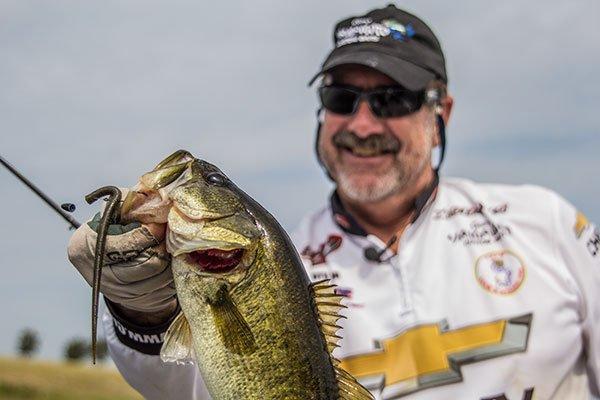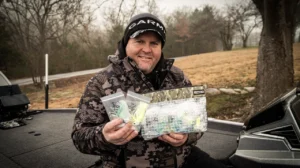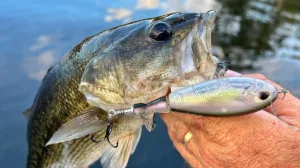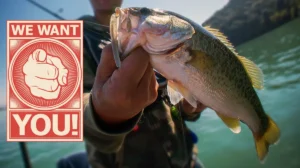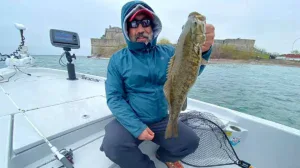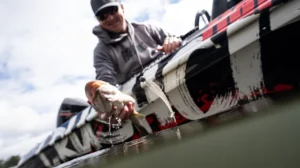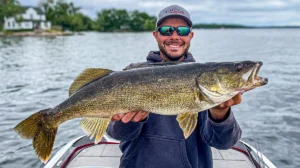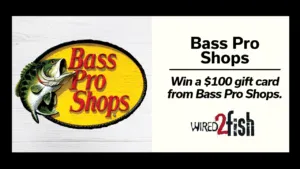It’s easy to become enamored with the latest tackle trends but one thing is certain—you should never overlook the effectiveness of bass fishing with plastic worms. It may not be as sexy as heaving an umbrella rig on a river ledge or working a topwater frog across matted vegetation, but it’s arguably the most effective bass fishing technique ever created.
FLW Tour pro and Bassmaster Classic champion Larry Nixon has made the majority of his living with three simple things—a hook, a weight and a plastic worm. Widely renowned as the best worm fisherman to pick up a rod, he believes there are 10 things you need to know in order to boost your confidence and success with this age-old, fish-catching technique.
1. A pegged sinker loses more fish
Whether we peg our Texas rigs with an old toothpick or a rubber bobber stop, we’re all guilty of it. It’s easier to skip under docks and it increases the longevity of your knot, so it’s all good, right? Nixon doesn’t necessarily buy into this theory.
“Plastic worms will always catch fish,” Nixon said. “It doesn’t matter where you are or what type of bass you’re targeting. They’re a bass angler’s dream.”
“I’ve always believed that a pegged sinker causes me to lose more fish,” Nixon said. “With the weight so close to the worm, a big bass will get both the sinker and the hook in its mouth, which can result in many missed opportunities. Now, if I’m trying to penetrate cover and sink the worm into a small, precise area, I really don’t have a choice but to peg it. If I’m casting a worm, however, 99 percent of the time my sinker is sliding free on the line.”
Being the meticulous professional he is, Nixon has spent countless hours examining the action of plastic worms in swimming pools. Years of constant experimentation have allowed him to realize the unique properties of an unpegged Texas rig.
“If you throw an unpegged Texas rig into the water and watch it, the weight hits the bottom about eight inches in front of your worm,” Nixon said. “Once the weight hits, the worm sinks downward like a dead-sticked Yamamoto Senko. I’ve always had so many quality bites at the beginning of my cast and I think that’s why.”
2. Your casting and pitching hooks shouldn’t be the same
Again, this is something we all do. We pitch to a piece of shallow cover, make our way down the bank and start casting to a brush pile with the same setup. Although it may be easier for us, Nixon advises against it.
“If you don’t have a straight shank hook when you’re casting a worm, it’s not going to look right in the water,” Nixon said. “I exclusively use the Roboworm Rebarb Hooks for casting because they give my worms a much more streamlined profile. Not to mention, the plastic always slides down at the hook eye upon a hookset, resulting in excellent plastic penetration and better hookups.”
When pitching a flipping a worm to cover, Nixon avoids big, heavy duty flipping hooks like the plague. In his opinion, the bigger hook you use, the more leverage you give the fish.
“I do not like heavy flipping hooks whatsoever,” Nixon said. “I use a thin wire 5/0 Gamakatsu Offset EWG Worm Hook instead. A thinner wire promotes good penetration and the gap is just big enough to penetrate the worm. If I can pin a bass between the hook and plastic, she’s mine; she’s not going anywhere.”
3. Not all plastic worms are the same
In order to get the most out of worm fishing, it’s important to realize what situation each type of worm is best-suited for. Just because two worms are green and wiggle when you twitch them doesn’t mean they’re the same.
Straight tail worm – A straight tail worm is the most versatile worm in existence, without a doubt,” Nixon said. “They’re more erratic, they sink very differently and come through cover well … there is no bad time for a straight tail worm. If you’re just starting out, I suggest using the Yamamoto 6.75-inch Long Pro Senko and a 5-inch Yamamoto Pro Senko to cover all your bases. During cold fronts, stick with the smaller size and bump up to the 6.75-inch model when you’re fishing in warmer water.”
Curly tail worm – “The curly tail worm, such as the Yamamoto 12-inch Curly Tail Worm, is at its very best when you have vegetation in a body of water,” Nixon said. “Whether you’re fishing milfoil, hydrilla or lily pads, it provides an extremely realistic swimming action in cover. I’ll also use it in brush piles and heavy cover so the fish don’t get a great look at it—just work it over limbs and let it fall through any holes.”
4. Fall rate is the determining factor in getting more bites
According to Nixon, the most important factor in getting strikes is your worm’s fall rate. You can jiggle and gyrate your worm in every way imaginable, but the speed at which your worm sinks to the bottom is essential.
“I choose my weight size in accordance to the depth I’m targeting and the behavior of the bass,” Nixon said. “You absolutely have to figure out the correct fall rate to catch more bass. If they get too good of a look at your worm, they won’t touch it. There’s no formula or guarantees because it changes every day, so it’s important to always try different weight sizes.”
As a general rule-of-thumb, Nixon utilizes a faster fall and presentation in clear water with a 5/16 or 3/8-ounce weight and a slower fall and presentation in dirty water with a 3/16 to 1/4-ounce weight.
“There are a lot of variables that determine weight selection, but I always tell beginners to start out with a 3/16 and 1/4-ounce weight,” Nixon said. “If it’s a tough bite in stained water, I’ll slow down with a 1/8-ounce weight and make longer casts. If I’m trying to force reaction bites in clear water or battling windy conditions, I might beef it up to a 3/8-ounce weight for a faster fall and a better feel of the bottom.”
5. Your rod is a tool, so use the right one
You probably shouldn’t use a pair of pliers to hammer a nail—you could, but it’s going to hinder your ability to get the job done correctly. Similarly, Nixon stresses the importance of using a versatile rod that can handle all kinds of worm fishing.
“Sensitivity is the most important thing to look for in a worm rod,” Nixon said. “If you don’t know when you have a bite, you’re not going to catch many fish. You also want to use a rod with a solid backbone that allows you to wrench big ones out of cover. Almost all of the time, you’ll see me using a 7-foot, medium-heavy Dobyns Champion Extreme Casting Rod for my worm fishing.”
6. Use fluorocarbon and maintain it well
Fluorocarbon is not only difficult for fish to see, but it also has very little stretch which promotes direct energy transfer on big hooksets. When you’re fishing with a worm, it’s important to drive the hook into the bass’ mouth past the barb. If not, you may have your heart broken.
“It’s hard to go wrong with 15-pound Seaguar InvizX Fluorocarbon,” Nixon said. “If I’m in clear water, I’ll drop down to 12-pound test and when I’m using a heavy sinker in thick cover, I’ll go up to 20-pound Seaguar AbrazX. If you use a line that’s too heavy, you’re going to be dealing with a lot of line management issues.”
Before each fishing trip, Nixon puts a lot of time into properly maintaining his fluorocarbon line. He uses a few simple tricks to keep even his older line performing like new.
Stretch it: ”If you haven’t been out in a week or so, take two minutes to hook your line to something and stretch it,” Nixon said. “Reel it back in with some tension and your first cast will feel like brand-new line. Fluorocarbon doesn’t absorb water, so it will coil if it sits on your reel for too long. If it coils, you’re not going to be able to feel what your worm is doing down there.”
Wet your knot: ”Regardless of the knot you tie, it’s important to wet your knot every single time you tie it,” Nixon said. “Fluorocarbon will burn itself if you cinch a dry knot and I can guarantee you’ll lose fish if that happens. Always take the extra time to tie a solid, wet knot.”
Don’t over-spool: ”Try not to put too much fluorocarbon on your reel,” Nixon said. “When you pack a bunch of line on, you’ll have a hard time controlling it. I use cheap monofilament line as backing followed by about 60 yards of fluorocarbon. Anything more is overkill—you won’t find any bass that’ll strip more than 15 yards of line, so there’s no sense in wasting a bunch of nice line.”
7. Hopping your worm will help you cover water quickly
When many of us started bass fishing with plastic worms, we were told to “drag and reel”. You can certainly catch fish with this retrieve, but if you’re looking to cover water and establish a productive pattern, hopping it may be a better alternative.
Stroke it: Nixon keeps a close eye on his Lowrance for suspended bass throughout the year. If they’re within a few feet of the bottom, he loves to stroke a Texas rigged worm to pick up a few extra bites.
“I’m almost always hopping my worm—I’m not much of a dragger,” Nixon said. “If you hop the worm about two feet and let it freefall to the bottom, you’re going to cover water as fast as a spinnerbait angler. When you run across a piece of brush or a break line, that’s when you need to slow it down.”
Nixon believes his ability to quickly fish a plastic worm is the driving factor behind his illustrious career. He purposely blazes through stretches of bank until he is able to put together a pattern.
“When I’m looking for fish, I’m going to cast a worm into an area, hop it twice and move on,” Nixon said. “I’m just looking for a few key bites that will tell me where the fish are positioned. If a bass is there, they’re probably going to eat it. You’re looking to dissect open water and cover with as few casts as you can get away with.”
8. Tungsten makes all the difference, but be careful
Unless he’s using a weight smaller than 1/4-ounce, Nixon is a huge believer in the sensitivity and subtle profile of tungsten sinkers. There is one requirement, however, that they must have before he even thinks about using them.
“The benefits of tungsten are undeniable, but you have you be extremely careful with it,” Nixon said. “No matter what people say, if a tungsten weight doesn’t have an insert, it’s going to cost you a fish—I’ve seen it happen far too many times. If you feel your line within 1/4-inch of your hook, it’ll be roughed-up if you’re not using an insert. That’s the tungsten doing that—it’s just like a razor blade.”
Quick tip: When your sinker collides with cover, it will cause your worm to jump which can result in vicious reaction strikes. If it starts feeling rough throughout your retrieve, slow down and run your sinker across the “good stuff”.
Before you throw away all of your expensive insert-less tungsten weights, there’s a way to save your investment and protect your line in the process.
“If you don’t want to lose fish, you can insert shrink tube into your tungsten weights,” Nixon said. “It will keep any sharp edges away from your line and enable you to fish with peace of mind.”
9. Common mistakes are very avoidable
Nixon discovered the magic of plastic worms as a guide many years ago on Toledo Bend. While other guides were having problems catching quantity and quality, he and his clients were having incredible success with worms. This time spent teaching novice anglers gave him a unique insight into common worm fishing mistakes. Luckily, they’re all easy to fix.
“A lot of people fish a worm too fast,” Nixon said. “It’s tempting to continuously cast and wind, but you have to be very deliberate in your presentation. I also see a lot of anglers using hooks that are way too big for the application. You don’t need an enormous hook when you’re worm fishing; a 4/0 hook will do the job just fine.”
Nobody likes breaking off a big bass, but it’s important to avoid using huge line. If you’re able to feel the action of the worm, you’ll have a much better idea of what your worm is doing.
“I think people tend to use heavier line that overpowers the worm,” Nixon said. “You’re going to get a lot more bites if you use smaller line because it sinks better, looks more natural and is easier to manage on your reel. With that being said, you always need to be aware of the size of the bass in a given fishery. If you go to Lake Falcon, throw it all out the window and buy whale rope.”
10. Don’t be afraid to swing and miss hooksets are free
Learning to detect bites can be a frustrating obstacle to overcome when you’re learning to fish a worm, but there are a few ways to quickly get the hang of it.
Hit ’em twice: If Nixon gets bit on a long cast, he’ll crank the reel handle about five times after the initial hookset and set the hook a second time. This ensures he gets the barb of the hook through the bass’ mouth.
“As soon as I feel tension and feel like there’s a slight possibility of a bite, I’m going to set the hook,” Nixon said. “Sometimes you whiff on it, but you never know until you try. It’s important to realize, however, that you’re not always going to feel a big “bump” on the end of your line. A lot of times it will feel mushy or simply swim to the side without you feeling anything at all. You have to be a constant line-watcher and be ready to react if it does anything out of the ordinary. If you feel the fish, you can bet he feels you so you better do something quickly!”
Bass fishing with plastic worms is effective throughout the entire year and if you put effort into it, it’s a technique that will catch fish when other techniques fall short. With these simple tips, you’ll be able to catch more fish and gain more confidence in an overlooked bait that has withstood the test of time.
